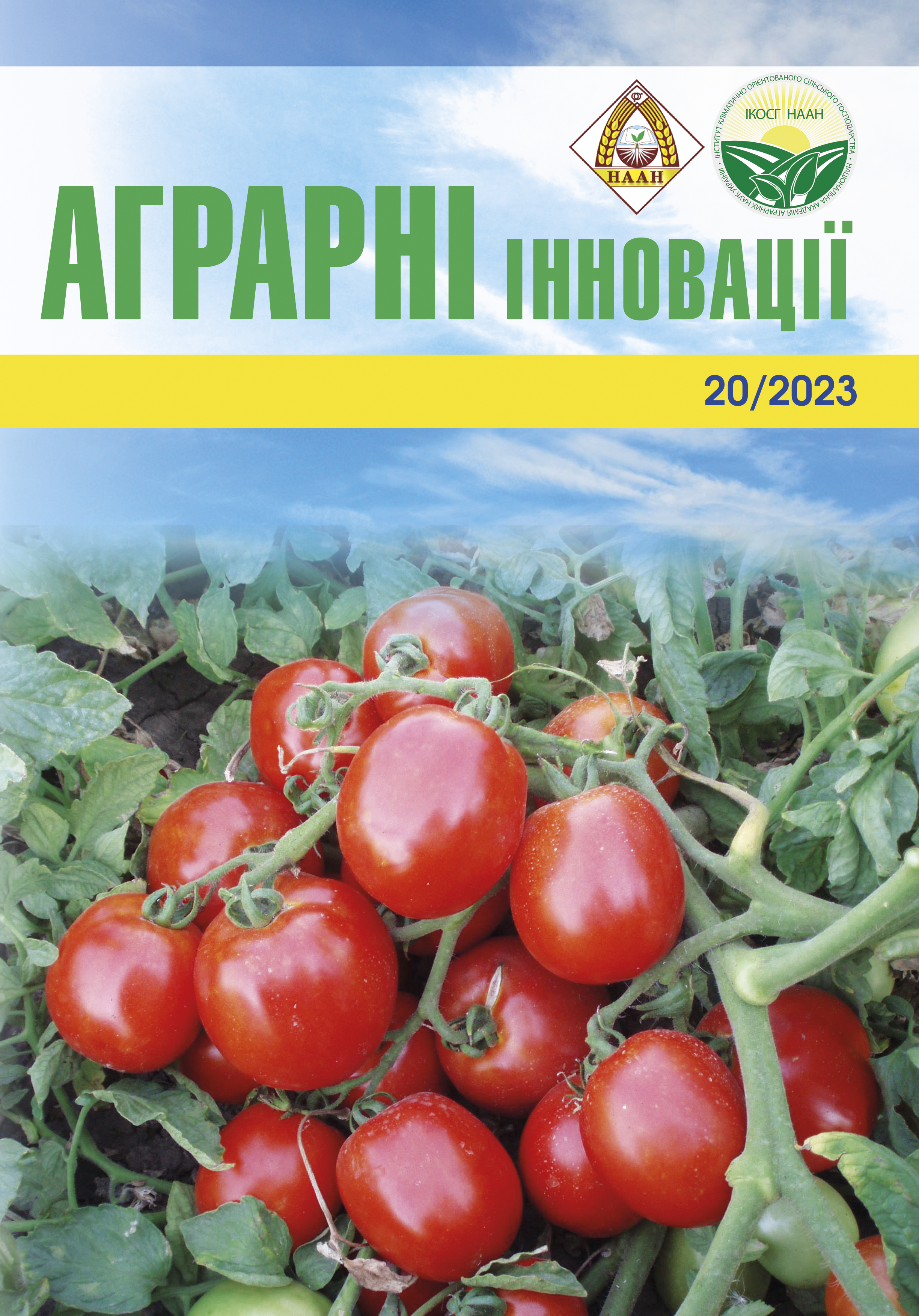Dependence of the productivity of kohlrabi cabbage on the density of plant placement
Abstract
The article presents the results of a study of the dependence of productivity of kohlrabi cabbage on the layout of plants. The density of plant placement is important in the formation of the kohlrabi cabbage crop. In thinned plantations, plants are well lit, soil nutrition conditions are improved, and as a result, the yield of each plant increases. However, with an increase in the feeding area, the yield usually increases more slowly than with an increase in plants per unit area. Thus, the issue of the density of kohlrabi cabbage plants is relevant and needs to be studied. The purpose of writing the article is to analyze the placement schemes of kohlrabi cabbage plants and their influence on the productivity of stem crops. Methods. The research was carried out at the research field of the Department of Fruit and Vegetable Growing and Storage of the V. Dokuchaev Kharkiv National Agrarian University during 2012–2014 in accordance with the “Methodology of research in vegetable growing and melon growing”. The object of the study is kohlrabi cabbage of the Snizhana variety, early ripening, entered in the State Register of plant varieties suitable for distribution in Ukraine. The results. Planting of seedlings began in the phase of formation of 3–4 leaves. Thus, 28–30 days passed from the moment of sowing the seeds to the planting of seedlings. The duration of the growing season from seed sowing to technical ripeness was 78 days on average in the variants with a density of 47.6 and 71.4 thousand pieces/ha. When kohlrabi cabbage plants were thickened to 107.5, 142.8, and 212.7 thousand pieces/ha, the phase of technical ripeness came on average five days earlier, as the plants quickly transitioned to the phase of stem formation. A direct relationship between productivity and plant density has been established – the higher the density, the higher the productivity. However, it should be taken into account that with a significant increase in density, the marketability of the crop is partially reduced. The highest commercial yield was obtained by us with the schemes of placing plants (40+40+60) x 10 cm and 70x10 cm, 26.2 and 21.9 t/ha, respectively. The percentage of standard production was higher than the 70x10 cm placement scheme – 87%, in terms of the yield of standard production – 17.4 t/ha. Conclusions. The conducted studies showed that, on average, during the three years of research, at all investigated growing densities, kohlrabi cabbage plants formed standard stems both in terms of size and weight, but their yield was different. According to the results of the study, the best schemes for placing kohlrabi cabbage plants are (40+40+60)x10 cm and 70x10 cm, which provided the highest yield of the marketable crop.
References
2. Vasylkovska K., Andriienko O., Malakhovska V. and Moroz O. (2022). Analysis of changes in comfortable sunflower growing areas using the example of Ukraine. HELIA, 45(77). 175–189. (DOI: https://doi.org/10.1515/helia-2022-0010)
3. Пузік Л.М., Колтунов В.А., Романов О.В., Бондаренко В.А., Гайова Л.О., Щербина Є.В. Капустяні овочі. Технологія вирощування і зберігання: колективна монографія. – Харків: Видавець Іванченко І.С. 2015. С. 374.
4. Жук О.Я., Сич З.Д. Насінництво овочевих культур: навчальний посібник. – Вінниця: Глобус-Прес. 2011. С. 450.
5. Яровий Г.І., Романов О.В. Овочівництво: навчальний посібник. – Харків: ХНАУ. 2017. С. 376.
6. Щербина Є.В. Урожайність і якість продукції капусти кольрабі залежно від строків і способів вирощування. Вісник Харківського національного аграрного університету. Серія: Рослинництво, селекція і насінництво, плодоовочівництво і зберігання, № 1. – Харків: ХНАУ. 2018. С. 148–152.
7. Срібна І.М. Вплив схеми розміщення рослин на врожайність брюссельської капусти. Вісник Білоцерківського державного аграрного університету, Вип. 35. Біла Церква: БДАУ. 2006. С. 122–126.
8. Сидорова І.М. Залежність площі листкової поверхні рослин капусти брюссельскої від схем розміщення. Нові пошуки молоді у третьому тисячолітті. Матеріали VI державної науково-практичної конференції молодих вчених, аспірантів та докторантів. – Біла Церква: БДАУ. 2007. С. 45.
9. Федосій І.О. Площа листкової поверхні та врожайність капусти савойської залежно від схеми розміщення рослин. Вісник Білоцерківського державного аграрного університету, Вип. 37. – Біла Церква: БДАУ. 2006. С. 118–125.
10. Бондаренко Г.Л., Яковенко К.І. Методика дослідної справи в овочівництві і баштанництві. – Харків: Основа. 2001. 369 с.
11. Васильковський О., Лещенко С., Васильковська К.,. Петренко Д. Підручник дослідника: Навчальний посібник для студентів агротехнічних спеціальностей. – Харків: Мачулін, 2016. 204 с.






